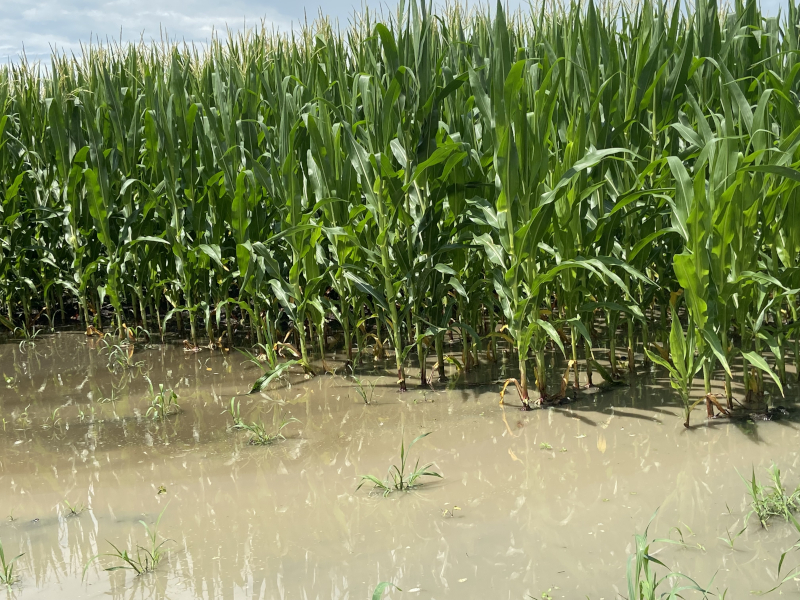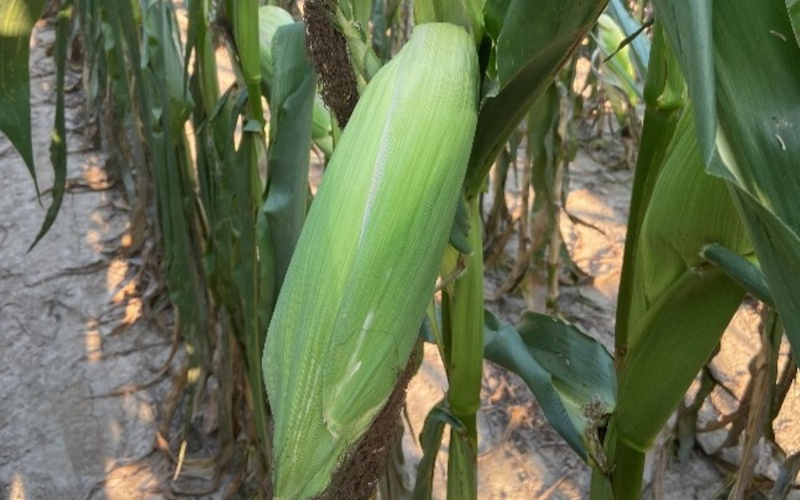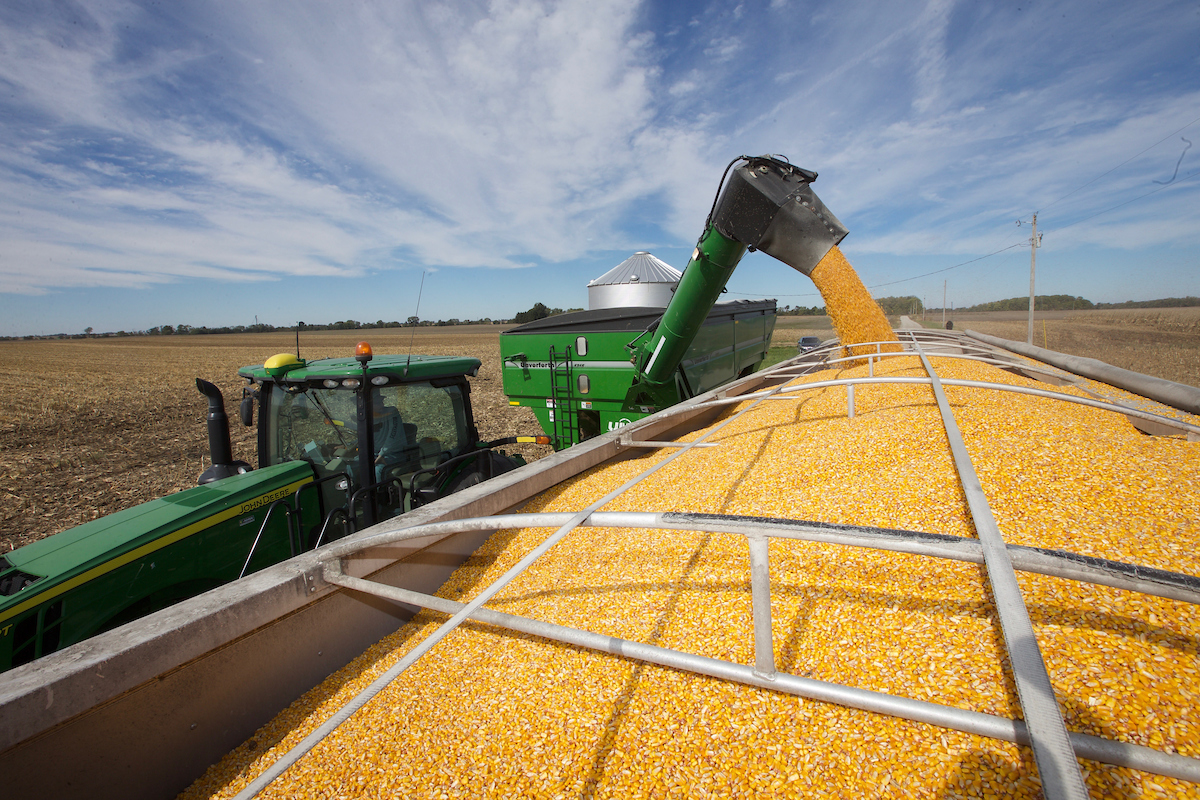Potential Impacts of Heavy Rainfall and Recent Flooding on Corn Growth and Yield
In the last week, much of Indiana has received the remnants of Hurricane Beryl, with various locations receiving rainfall totals of 3-4+ inches of rain. With this occurrence of heavy rainfall, the risk of potential flooding and saturated soils also increases, especially in poorly-drained soils, low-lying areas of fields, and fields close to creek and river bottoms. So, the question that always gets asked is, what impacts will flooding and saturated soils have on corn growth and yield? And the answer to this question is “well, it depends” (using this answer is an essential part of my training). The overall extent of flooding injury to corn is determined by multiple factors such as 1) what growth stage was the corn plant at when the flooding occurred, 2) how significant was the flooding and where on the plant did the water rise to, 3) how long did the flooding occur 4) what were the air and soil temperatures at the time of the flooding, and 5) how much mud or debris are on the corn plants once the water has drained?

Understanding the growth stage of the corn plant and the level at which the water reached on the corn plant at the time of the flooding or ponding is important. Corn that is younger than V6 (six fully exposed, collared leaves) is more susceptible to flooding than corn that is older than V6 (Nielsen, 2019). The growing point of corn at or below the V6 growth stage is at or below the soil surface. Therefore, corn plants at this stage are more likely to be completely submerged, thus causing significant damage to the corn growing point and plant death rather quickly. Within about 48 hours, the supply of oxygen in a flooded soil is depleted and the growing point can no longer respire and perform critical functions (Lauer, 2008). If temperatures are warm or greater than 77 degrees F, which is consistent with the temperatures recently experienced in Indiana, corn plants that are fully submerged above the growing point may not survive after 1-3 days. Higher soil and air temperatures increases plant growth and warm water contains less oxygen than cool water (Ciampitti et al., 2021). To confirm plant survival, wait at least 3 days after the water is drained from the field and check for new leaf growth and the health of the growing point. The health of the growing point can be assessed by splitting the stalk. Healthy growing points will be white or cream-colored, whereas dead growing points will be dark and soft (Lee et al., 2007). Corn survival increases significantly if water levels do not submerge the growing point of plant and if the growing point was submerged less than 48 hours (Ciampitti et al., 2021).
Corn root growth and function can also be significantly harmed following flooding, especially after soil oxygen has been depleted. The longer an area of a field is flooded, the risk of yield loss and even plant death increases, even if the plants aren’t completely submerged and continue to photosynthesize. Without oxygen in the soil, corn plants cannot perform critical functions such as nutrient and water uptake, and root growth inhibition and even death will also occur. Certain areas of the state still has corn that is in the rapid growth phase and has not reached pollination. Therefore, restricted water and nutrient uptake due to poor root function caused by flooding has the potential to impact corn ear size, specifically kernel number. Whereas, another large portion of the state has corn that is currently in pollination. Therefore, root system damage to the corn plants at this growth stage could potentially increase photosynthetic stress during this pollination period and grain fill later in the season due to reduced root function, thus harming yield.
Flooding can also cause soil and mud to be deposited on corn leaves and within the whorl. This can potentially harm recovering plants and limit overall photosynthesis by hindering the plants ability to capture sunlight and may also damage the waxy surface layer of the leaf. In addition, soil and mud deposited on the leaves, stalks, and within the whorl can encourage the development of fungal and bacterial diseases in the damaged plant tissue (Nielsen, 2019; Ciampitti et al., 2021). Furthermore, if flood water rises above the developing corn ear, ear rots can occur.
Lastly, flooding and ponding can cause significant losses of soil nitrogen from either leaching or denitrification. Fertilizer that is in the form of nitrate is negatively charged and has the ability to move through the soil profile and below the corn root zone following significant rainfall events. This is most likely to occur on coarse-textured, or sandier soil types. In much heavier soils, or low-lying areas of fields where ponding occurs, nitrogen loss most likely occurs due to denitrification. This is caused by the lack of oxygen which causes an anaerobic environment and results in microbes converting plant available nitrate to nitrous oxide or di-nitrogen gas, which can escape from the soil and into the atmosphere (White, 2018). Determining the amount of nitrogen that is lost and if a supplemental application of nitrogen fertilizer should be made is often difficult and can be inaccurate due to the many factors that influence this decision. Specific factors include, nitrogen fertilizer source used, percent nitrate of fertilizer source used, time of fertilizer application, amount of time between fertilizer application and rainfall event, duration of saturated soil conditions, soil temperatures following fertilizer application, and soil texture. Fields that are showing signs of significant nitrogen stress following a flood event prior to pollination will likely benefit the most from a supplemental N application.
Dan Quinn, PhD
Assistant Professor of Agronomy
Extension Corn Specialist
Purdue University
djquinn@purdue.edu






